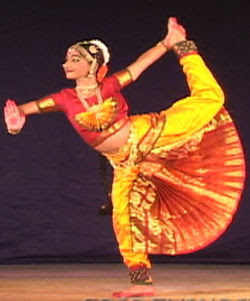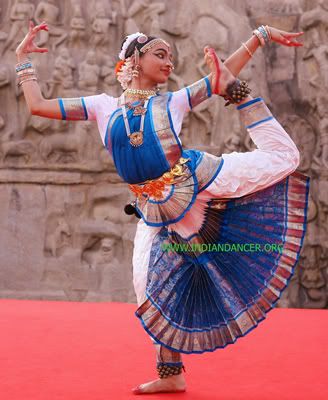Tamil classical dance Bharata Natyam!
This is my dance style , u know cultural !
Bharata Natyam
Bharatanatyam is a classical Indian dance form originating in the South Indian state of Tamil Nadu. This dance form denotes various 19th and 20th century reconstructions of Sadir, the art of temple dancers. Sadir in turn, is derived from ancient dance forms. Another aspect of this dance is Acrobatic Bharatanatyam. More information can be seen below. Bharatnatyam is usually accompanied by Karnataka Sangaath. It has its inspirations from the sculptures of the ancient temple of Chidambaram. Bharatanatyam, as the name depicts is the combination of:
'Bha' - Bhavam (means expression), 'Ra' - Ragam (means music), 'Ta - Talam (means beat or rhythm) and Natyam (means dance) in Tamil.
Bharatanatyam is a reworked dance-form from the traditional "sadir" known for its grace, purity, tenderness, and sculpturesque poses. Today, it is one of the most popular and widely performed dance styles and is practiced by male and female dancers all over the world.

Items
Typically a performance includes:
- Alarippu - A presentation of the Tala punctuated by simple syllables spoken by the dancer. This really is sort of an invocation to the gods to bless the performance.
- Kautuvam - Ancient temple dance item performed in the beginning of the recital, containing rhythmic syllables sung for jathis.
- Ganapati Vandana - A traditional opening prayer to the Hindu god Ganesh, who removes obstacles. See also Pushpanjali
- Jatiswaram - An abstract dance where the drums set the beat. Here the dancer displays her versatility in elaborate footwork and graceful movements of the body.
- Shabdam - The dancing is accompanied by a poem or song with a devotional or amorous theme.
- Varnam - The center piece of the performance. It is the longest section of the dance punctuated with the most complex and difficult movements. Positions of the hands and body tell a story, usually of love and the longing for the lover.
- Padam - Probably the most lyrical section where the dancer "speaks" of some aspect of love: devotion to the Supreme Being; or of love of mother for child; or the love of lovers separated and reunited.
- Stuti - Hymn in praise of a deity that may contain a feigned mockery, etc. See also Stotra
- Koothu - Item containing a lot of dramatic elements.
- Javali - Javalis are relatively new, pure abhinaya types of compositions of light and pleasing nature. Like Padams the underlying theme of Javalis is Sringara Rasa depicting the Nayaka-Nayaki bhava.
- Thillana - The final section is a pure dance (nritta) when the virtuosity of the music is reflected in the complex footwork and captivating poses of the dancer.
Apart from these items, there are items such as Shlokam, Swarajathi, Krithi etc. The performance concludes with the chanting of a few religious verses as a form of benediction. Certain styles include more advanced items, such as Tharanga Nritham and Suddha Nritham. When a dancer has mastered all the elements of dance, as a coming out performance, he or she generally performs an Arangetram (debut).
- Angikam - This is a devotional song on Lord Shiva and an item dance in bharatnatyam. It can also be performed in byapti slow motion.











Comments plz... ^_^
Comments